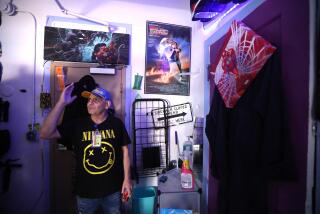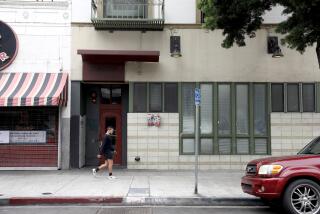Saving lives, saving money
If you pay taxes, Eddie Givens was costing you a fortune.
For the better part of 30 years, his life was a disaster. He was arrested dozens of times and cycled in and out of jails and hospitals, all of it on the public dime.
In his own words, Givens was a “blackout drunk” who passed out on the streets of downtown Los Angeles night after night. Each morning, he’d reach for the “vodka, scotch, whatever,” and start all over again.
“That was my breakfast,” says the 56-year-old New York native and former auto body repairman who occasionally cleaned up and moved indoors, only to quickly relapse.
Then one day late in 2007, Givens, who was known on skid row as “Wild Wild West,” got a surprise.
“A man and woman came up and said they had a program called Project 50. . . . They said, ‘We’ve got a place for you to stay.’ ”
Project 50, initiated by the L.A. County Board of Supervisors, had a bold objective: Select the 50 most hard-core, sick, chronically homeless people on skid row, give them a place to live with a raft of support services, and see what happens.
Would their lives be transformed? If so, how much would it cost taxpayers?
Nice idea. But then came the hard part. For starters, Project 50 required the collaboration of 24 city, county and nonprofit agencies, and history tells us the city and county don’t often work well together. Next came the problem of which homeless people should be included. But by the end of 2007, 350 pavement dwellers had been surveyed, and the 50 most vulnerable identified.
They were, in a manner of speaking, the walking dead. Among the 50, there was cancer, liver and kidney disease and HIV/AIDS. Roughly 90% had some form of mental illness. More than half had a history of substance abuse.
When it came time to move them into housing in early 2008, 14 of the 50 had disappeared, and six were in prison. The outreach team searched for replacements, and between January and May of last year, 49 people were moved from skid row and housed, most of them in downtown apartments run by Skid Row Housing Trust.
And today?
Four of the 49 are in jail or prison.
Two dropped out.
And the rest -- 88% -- are still indoors, including two people who were reunited with their families. A 50th person was recently housed but did not figure into the evaluation released last week, at the halfway point of the two-year program.
“By all accounts, it has been a success,” says L.A. County Supervisor Zev Yaroslavsky, whose staff, led by Flora Gil Krisiloff, got the project started and did much of the heavy lifting along with a nonprofit called Common Ground.
Some of the participants have slipped more than once, including Givens, whose story I’ll get back to in a minute. But for the most part the results have been remarkable. The majority of those with addiction problems have gone into rehab. All but two of the 39 diagnosed with mental illness are in treatment. Every participant has access to preventive healthcare, so hospital costs have plummeted.
In the next phase, Krisiloff said, she hopes to move some of the more successful participants into independent living situations. But with estimates of more than 70,000 homeless people in greater Los Angeles, Yaroslvasky acknowledged that Project 50 is just a start.
“What we’ve accomplished . . . is meaningful only insofar as we can take it to the next level, turning 50 into 500; and then 500 into 5,000,” he said. “We should commit to housing 500 of the county’s most vulnerable homeless persons by this time next year, and I will ask the Board of Supervisors to make that commitment this month.”
So how does the cost of housing and services compare to the cost of endlessly churning 50 people through jails, courtrooms and emergency rooms?
The numbers provided by Project 50 are a little squishy, in part because of one-time start-up costs and because state and federal funds were not counted into the net cost. Backers assert the net cost to the county was $892,000, or $540,000 not counting startup.
If that sounds like a lot, consider this: In the year before the program, Project 50’s participants cost the county an estimated $756,000 on hospitalization and incarceration.
Those numbers can be debated, of course, given the difficulty of breaking down specific costs in large institutions. But however you calculate it, one thing is clear: For roughly the same investment of county tax dollars, the bulk of the 50 are in recovery rather than a permanent state of decline here in the homeless capital of the United States. And there could well be long-term savings.
Givens’ studio apartment is nothing but four walls and a window, with a communal bathroom down the hall. But it’s a palace to him, and he showed it to me with pride Friday morning. Everything in it is neatly arranged, including a model of a 1951 DeSoto, cereal bars and canned vegetables he cooks in the common kitchen. Residents, most of whom get general relief or disability income, pay 30% of their income toward rent.
Givens said that on his first night there, it didn’t seem real.
“I made it,” he recalled saying to himself.
But that was in February, and Givens still had some of the wild stuff in him. He got the shakes and the sweats in rehab and walked away, then nearly got kicked out for a night of two-fisted boozing in the TV room of the apartment house. He was arrested yet again and spent some time in jail.
Still, he was determined to not blow a great opportunity. Like so many people on skid row, he suffered from a mental condition that went untreated for years, and psychiatric care along with medication helped him focus on recovery.
“I was tired of being sick and tired,” said Givens, who walks with a limp from being hit by a car a few years ago when he was so drunk, he didn’t feel the impact.
He went back to rehab a second time, fought through the shakes, and has been dry since August.
So what has that meant to you and me the taxpayers? In 2007, Givens landed in the emergency room 13 times for a total of 25 days. In 2008, he made only two trips for a total of three days. In 2007, he spent 10 days in jail; in 2008 just five, all of them before he sobered up.
His fight’s not over and he knows that, but Givens said he’s trying hard. He’d like to get back to work one day, but for now his primary goal is to stay sober.
“I’ll walk out there and a friend will offer me a drink, and I say, ‘No, I don’t want it.’ This time I’m serious about doing it.”
--
More to Read
Sign up for Essential California
The most important California stories and recommendations in your inbox every morning.
You may occasionally receive promotional content from the Los Angeles Times.










